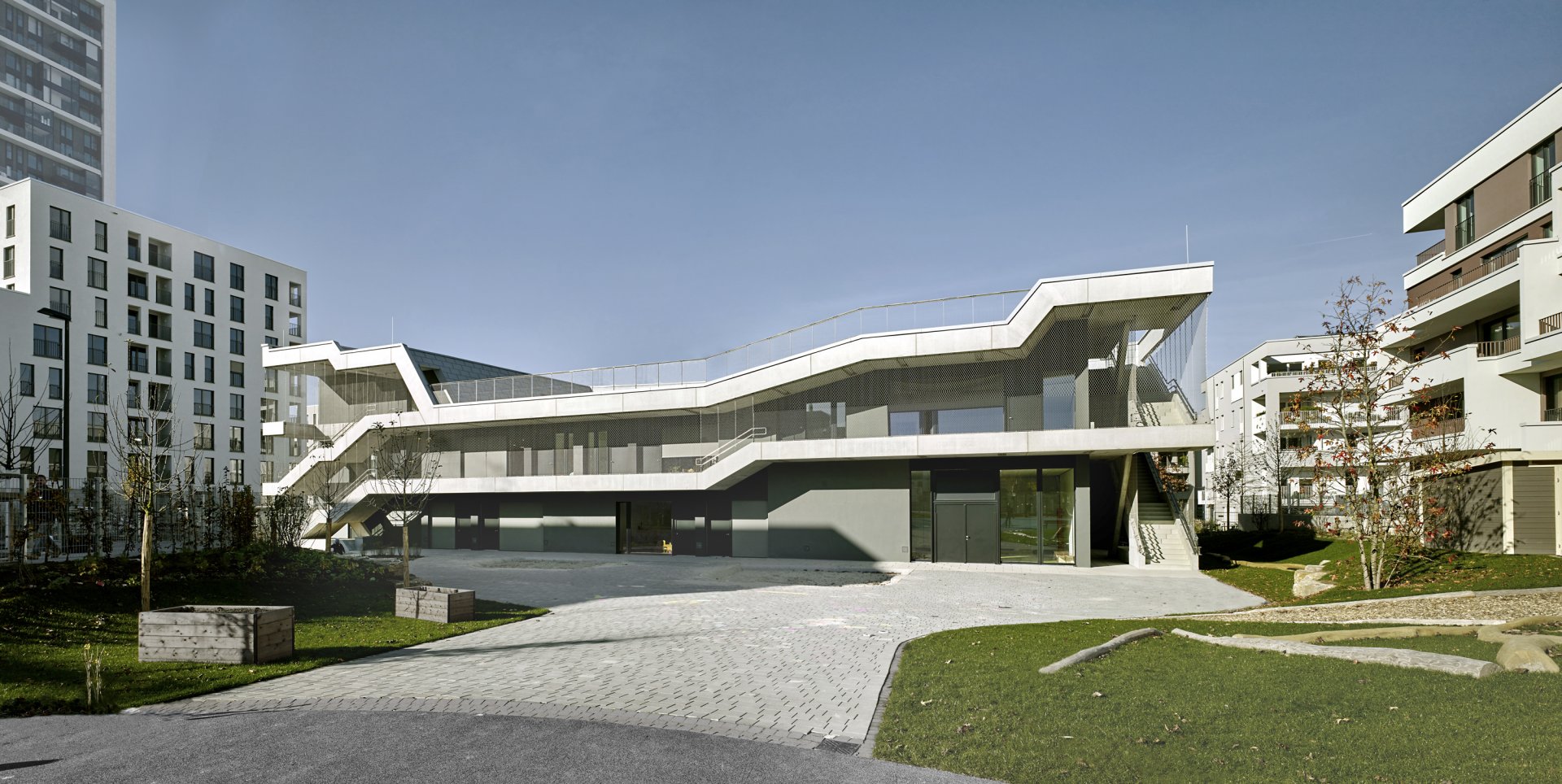
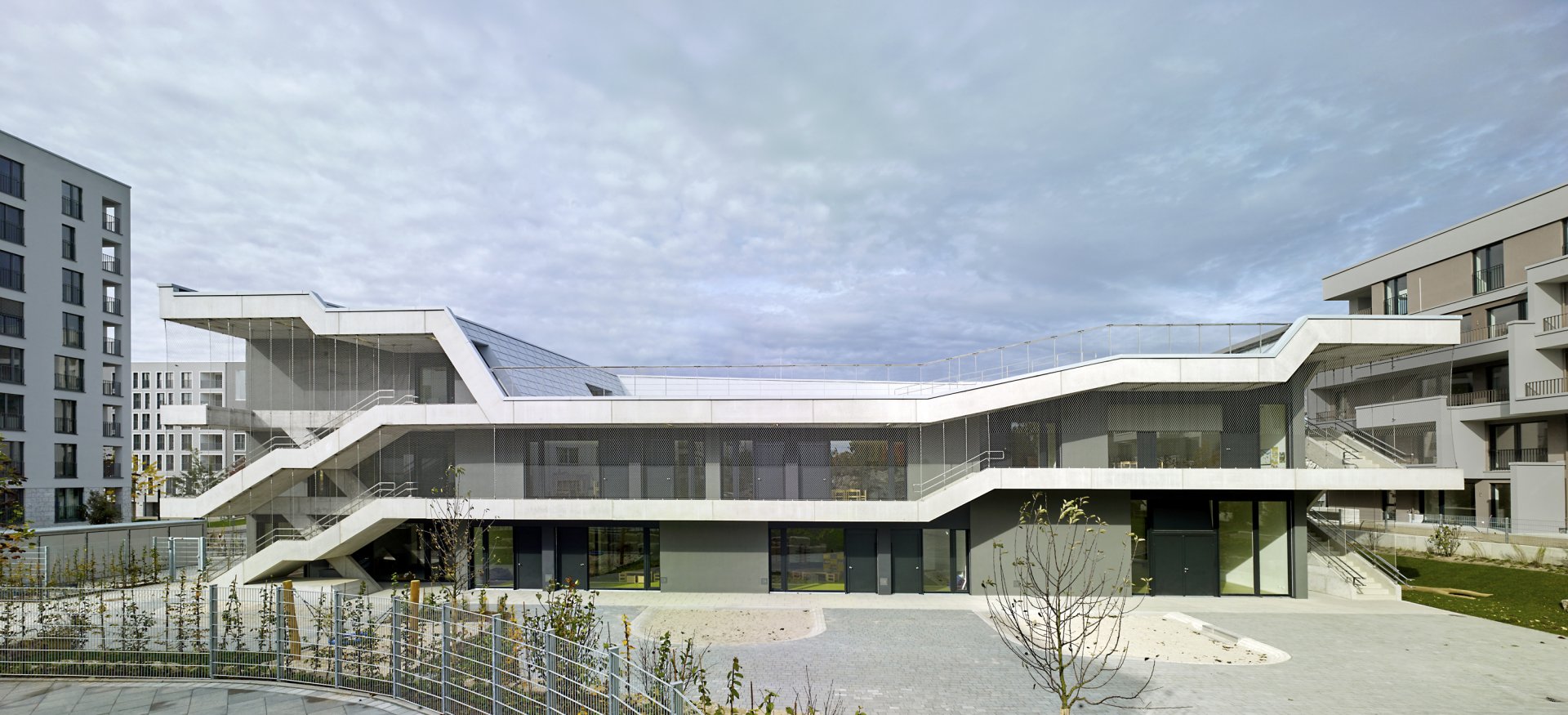
Kindergarten at Henninger Park
Frankfurt am Main, 2021
The new “Stadtgärten am Henninger Turm” residential quarter is being rounded out with a new-build childcare center. This childcare center is located in the heart of the quarter, right on the East-West promenade that leads from the historical Henniger Villa to the new Henninger Turm residential high-rise. Complementing the neighborhood shopping center in the building at the high-rise's base, the childcare center livens up the new shared heart of the Henninger district, which boasts almost 1000 apartments.
In line with the Henninger Park, which is situated in the direct vicinity, and the Sachsenhäuser Berg district, the underlying idea behind the project was to structure the building into folded topographical layers. These form different scenarios for play and learning – both inside and out of doors.
At the same time, the topmost layer can be perceived as a “roof world”. Alongside the possibilities of orchestrating the roof area there are two thermically enveloped levels presenting manifold opportunities for different kinds of usage. As well as conventional use, such as group rooms, workshops, etc., space will be made available for various kinds of open communication and play. In the process, various different room layouts and heights will be created. Everything becomes a play zone!
MoreA central indoor access area and the variously designed covered walkways are especially suitable for moving around in. The covered walkways with their access staircases made of fair-faced concrete represent a particularly successful transition between the inside and the outside. These spatial transitions face southwards, towards the large garden. At the same time, the projecting arcades offer protection from direct sunlight, thus preventing the building from heating up excessively. It also makes it possible to go out into the fresh air without being exposed to the rain when the weather is bad.
Directly adjoining these and flooded with sunlight are the bright group rooms for the children. The administrative rooms are arranged along the north side of the building.
The building has been designed as a simple concrete construction – the folded layers, walls, supports and staircases have been left untreated and can be interpreted as elements of the constructional structure. Depending on the functional requirement, layers of acoustic panels, wall covering, tiles or built-in furniture are added to the walls and ceilings. The color and material concept works with the tense relationship between the rough fair-faced concrete and the splashes of color represented by these additional elements.
The layers of fair-faced concrete are also a striking design element in the façade. Between the layers are solid slabs of high-insulation material with a greenish gray plaster surface and there are floor-to-ceiling window elements.
On the north side facing the promenade the building seems more closed – only the fully glazed play area on the ground floor can be looked in on. By contrast, on the south side all the rooms are generously glazed and look out onto the park. The balconies and the arcades have a safety barrier in the form of stainless-steel netting.
In concrete terms, the building features two main stories plus a roof story. It provides rooms for three groups of toddlers (0-3 years), three kindergarten groups (3-6 years) and two children’s groups (6-10 years) and can take about 142 children in all. In other words, the new kindergarten not only has room for the children from the new quarter but also for the wider surrounding urban environment in the Sachsenhäuser Berg district.

Association rice terraces
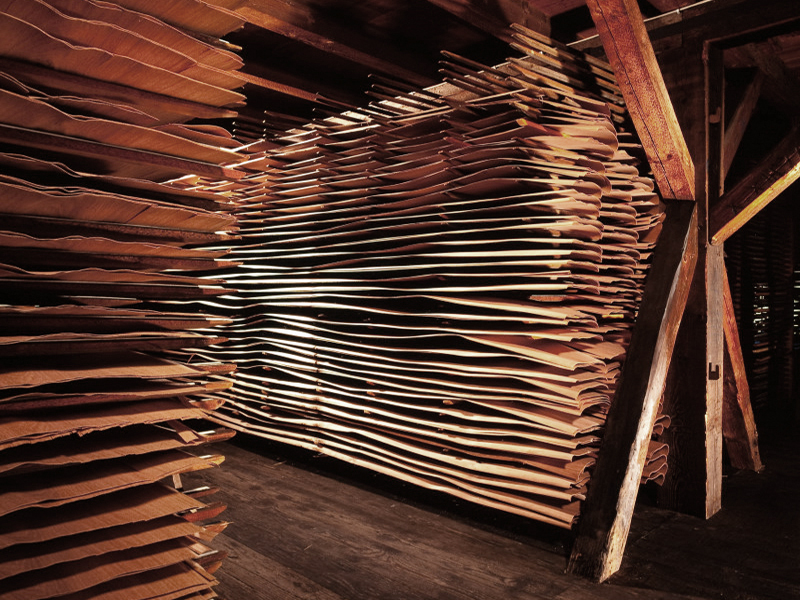
Association veneer storage
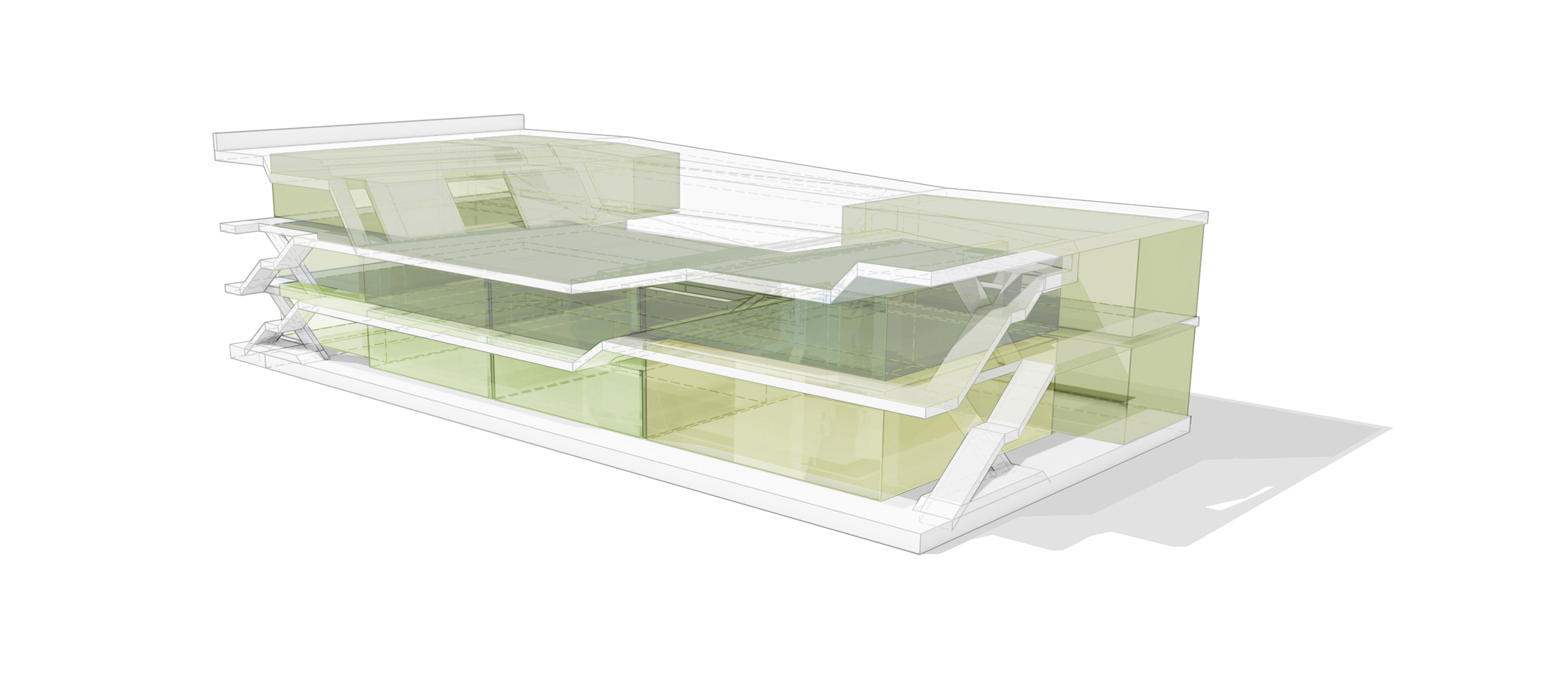
Building structure
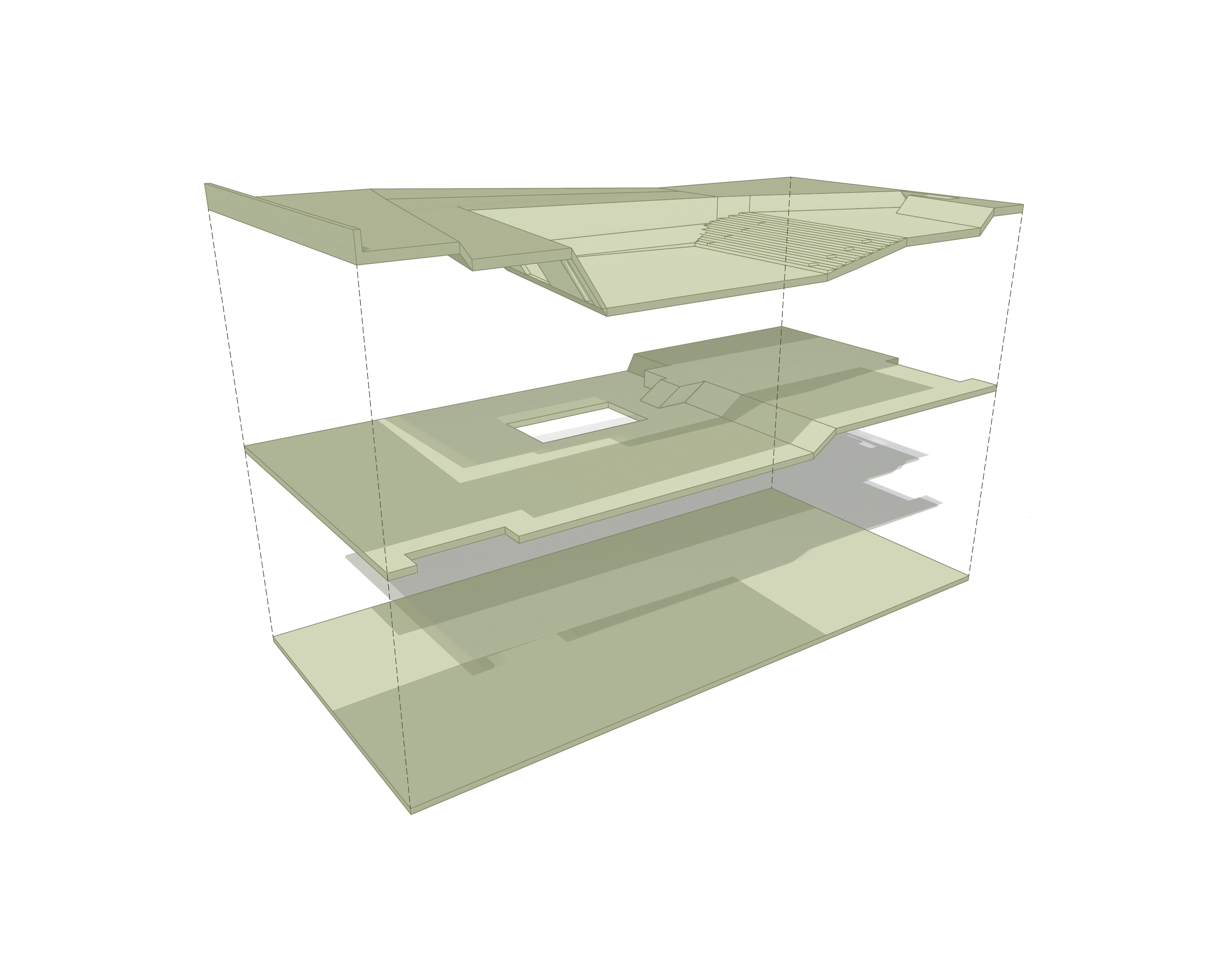
Layering of different playzones

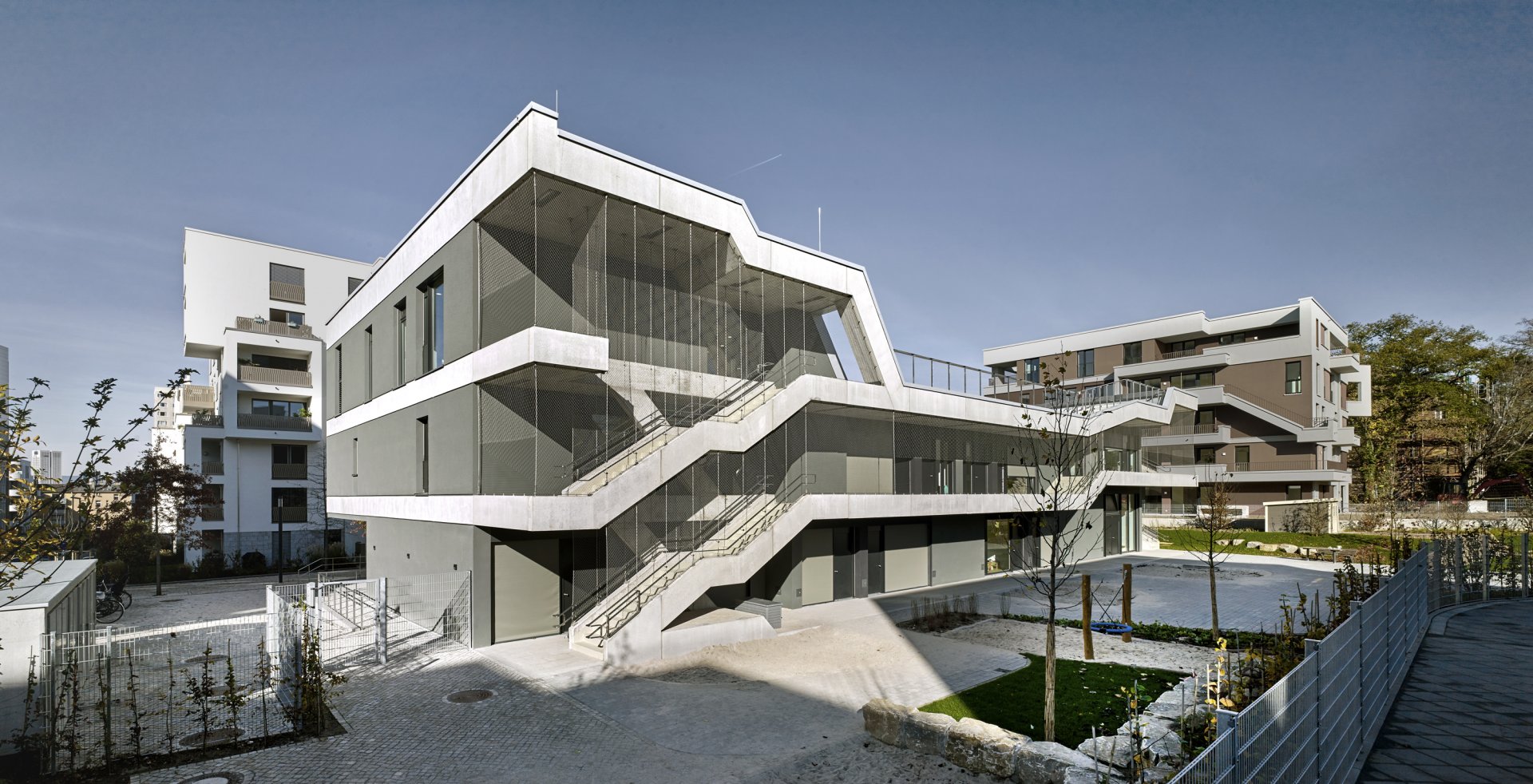
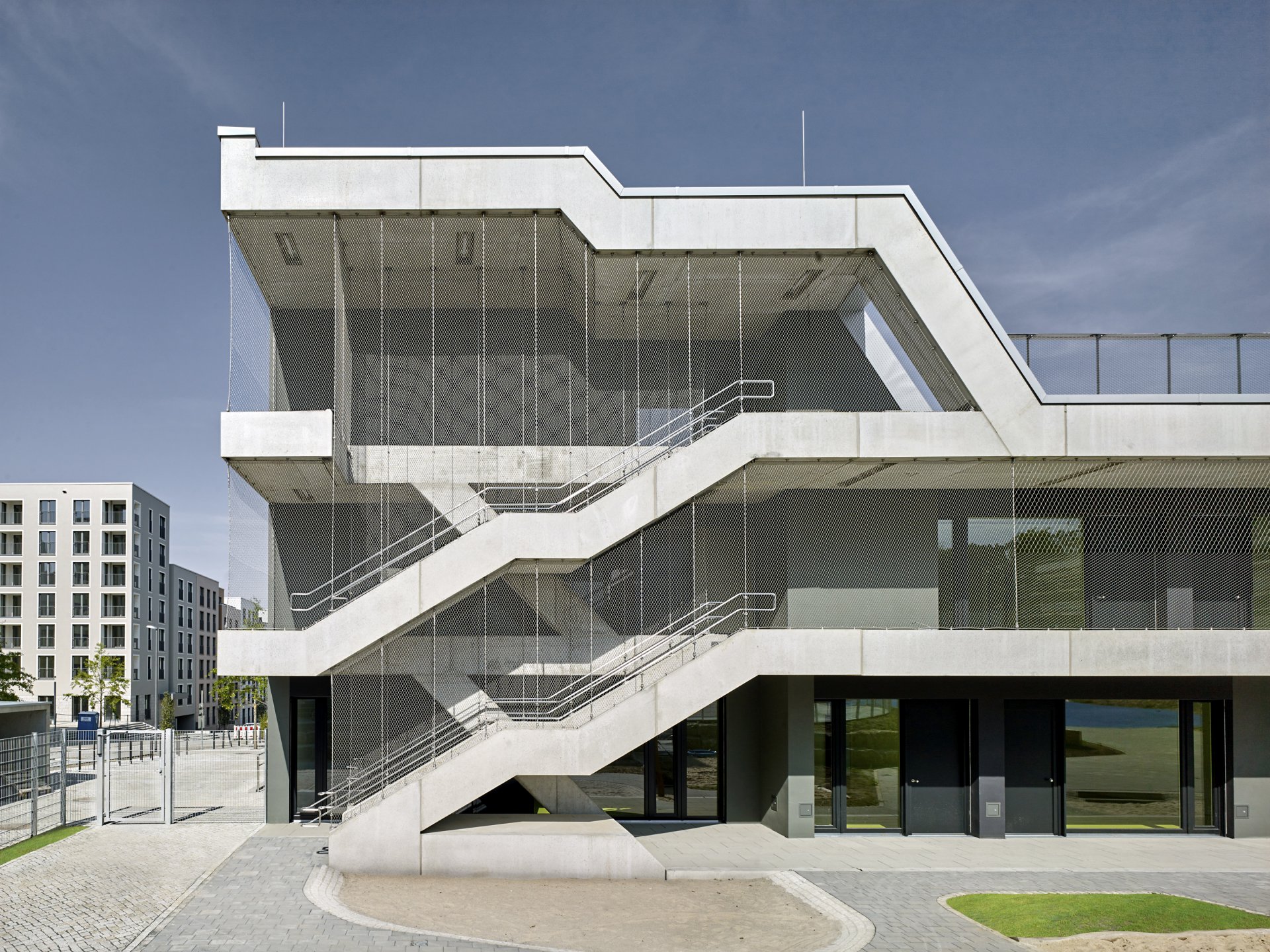
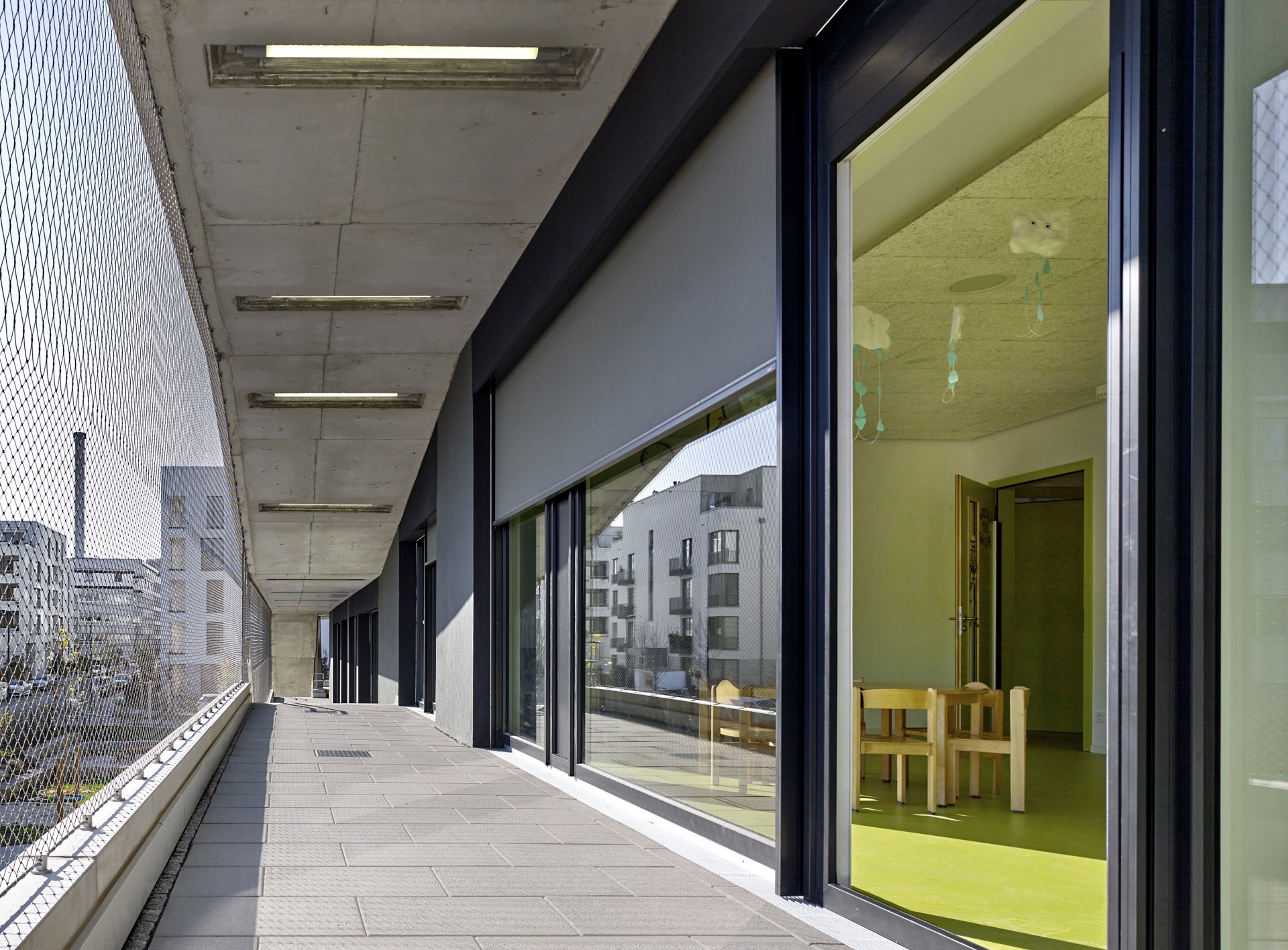
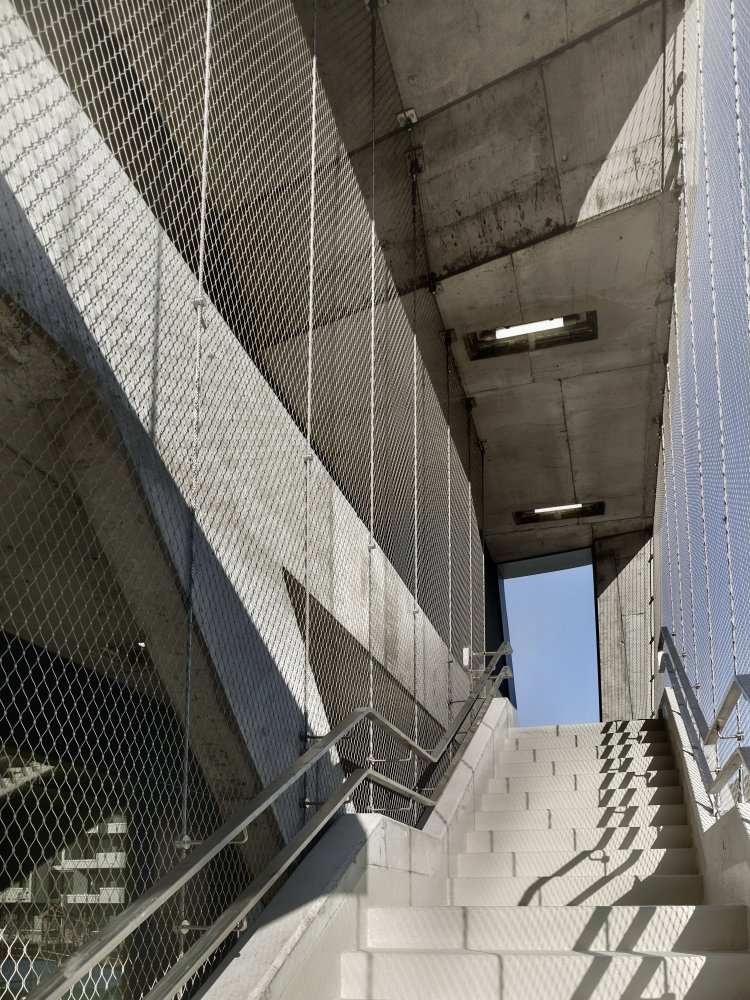
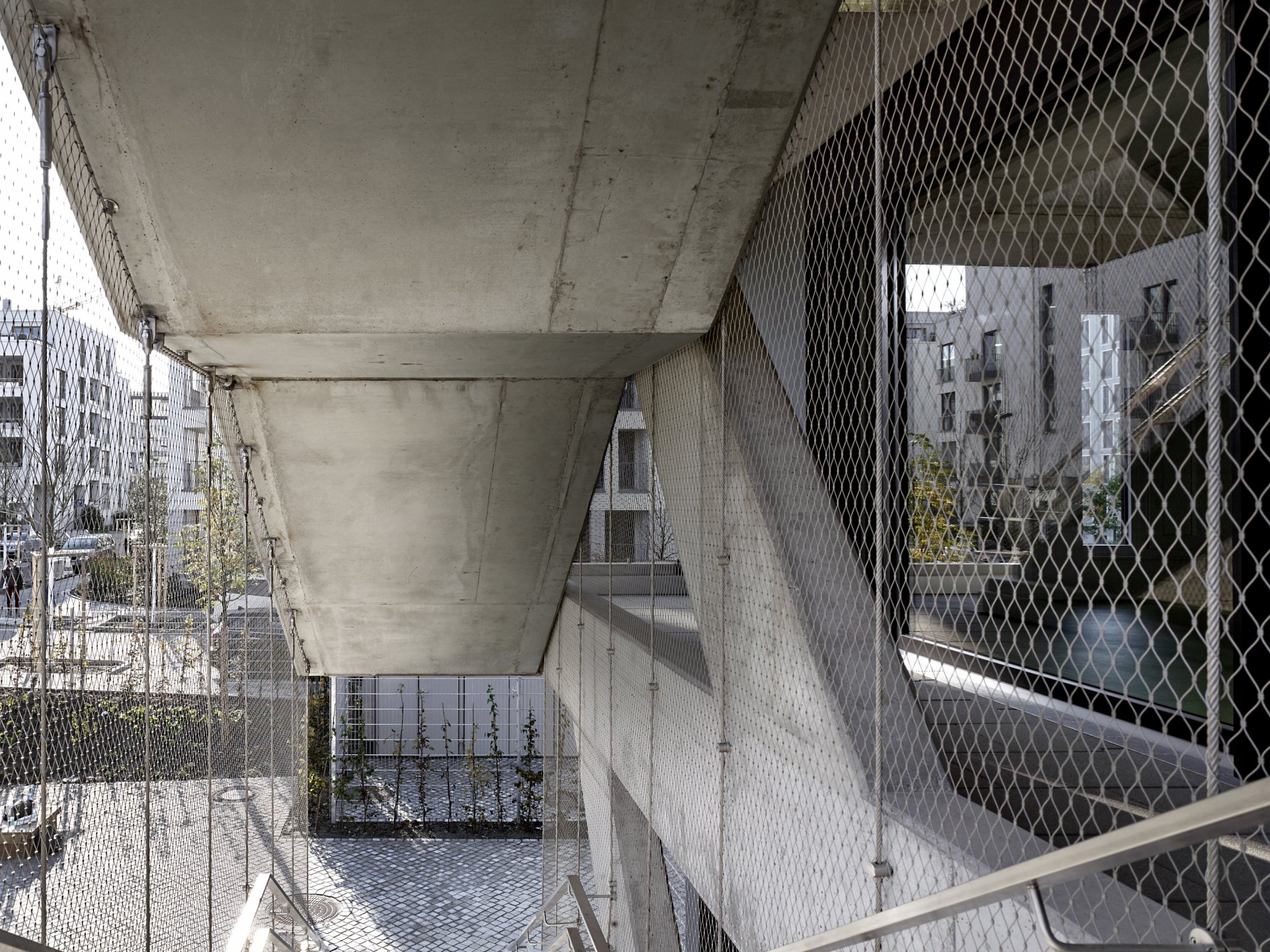
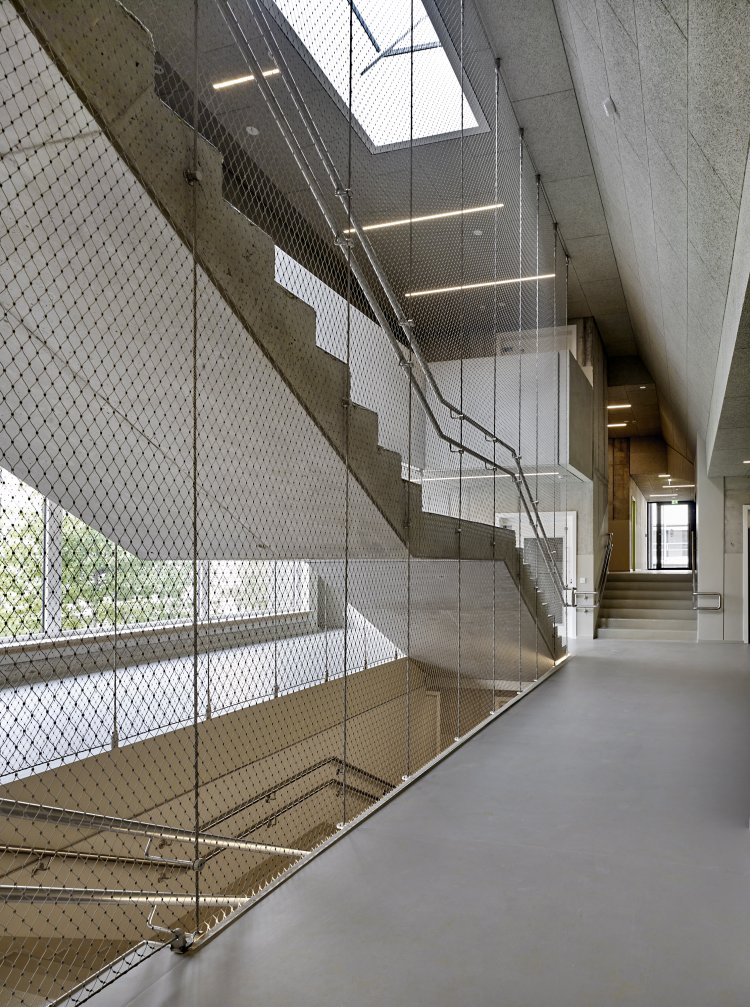
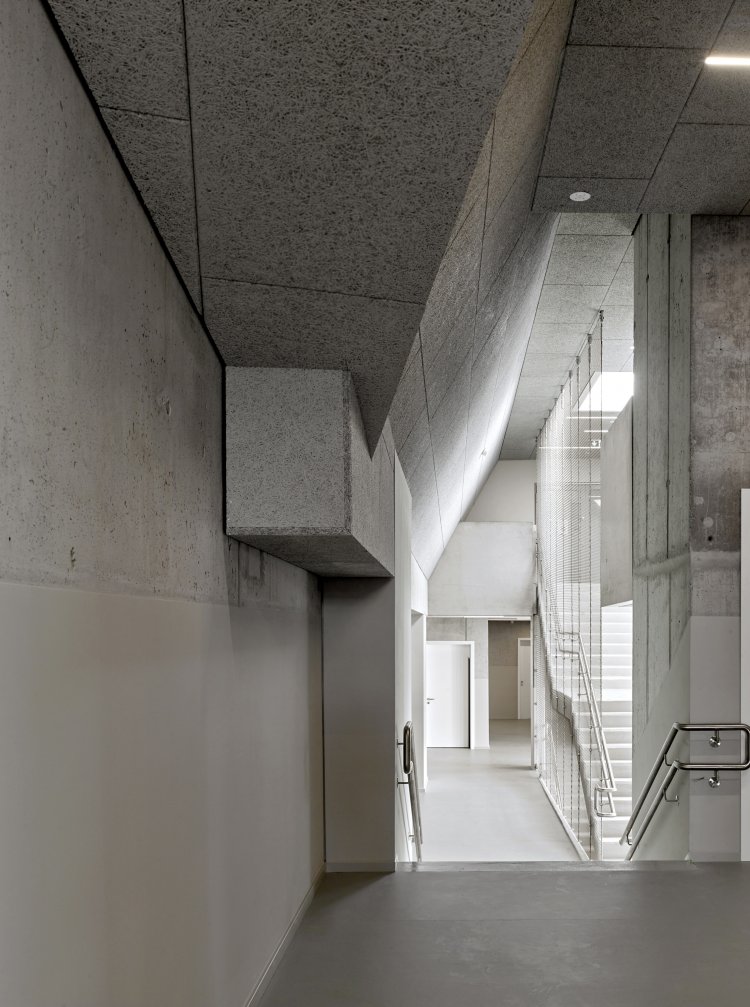
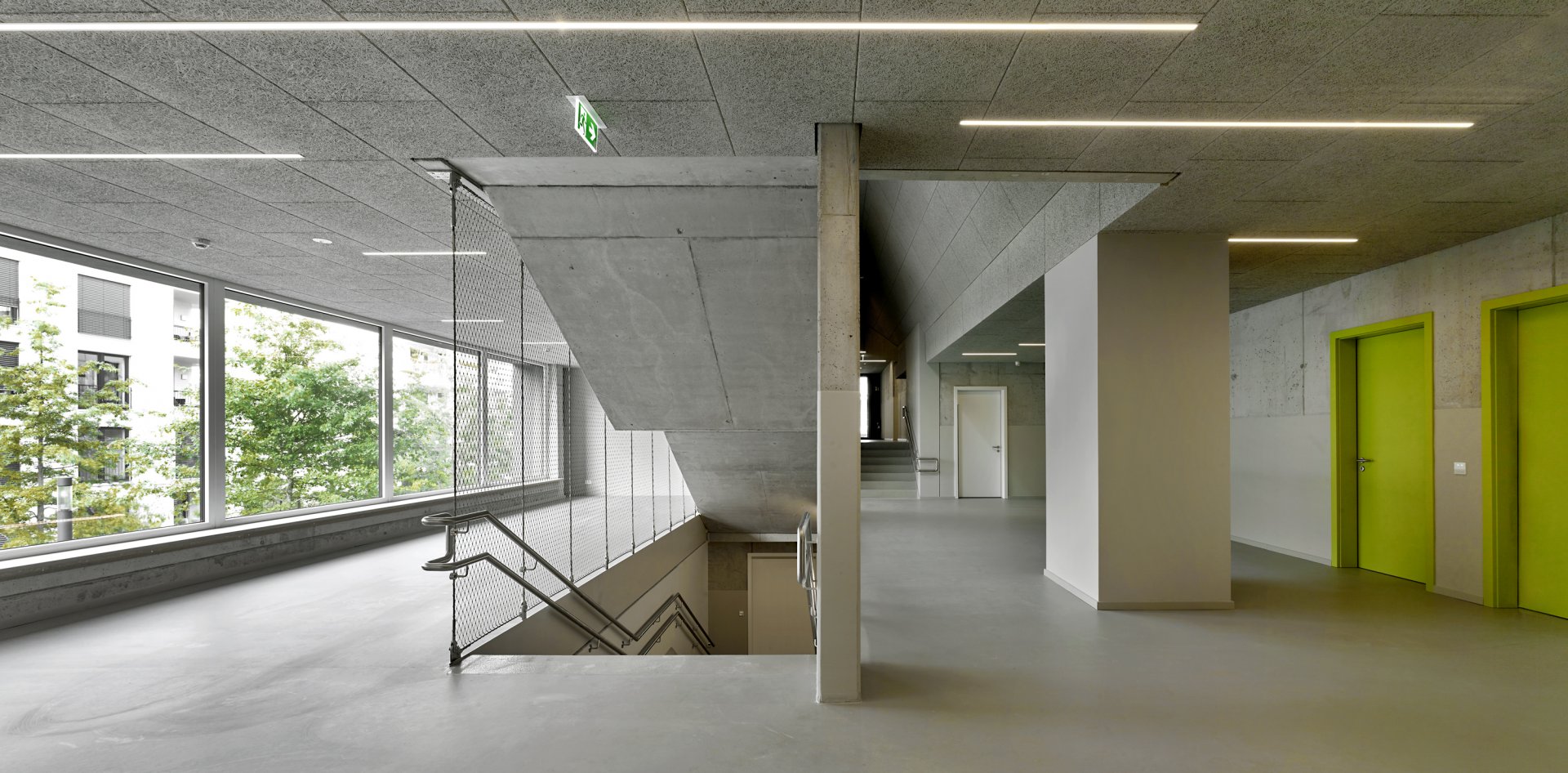
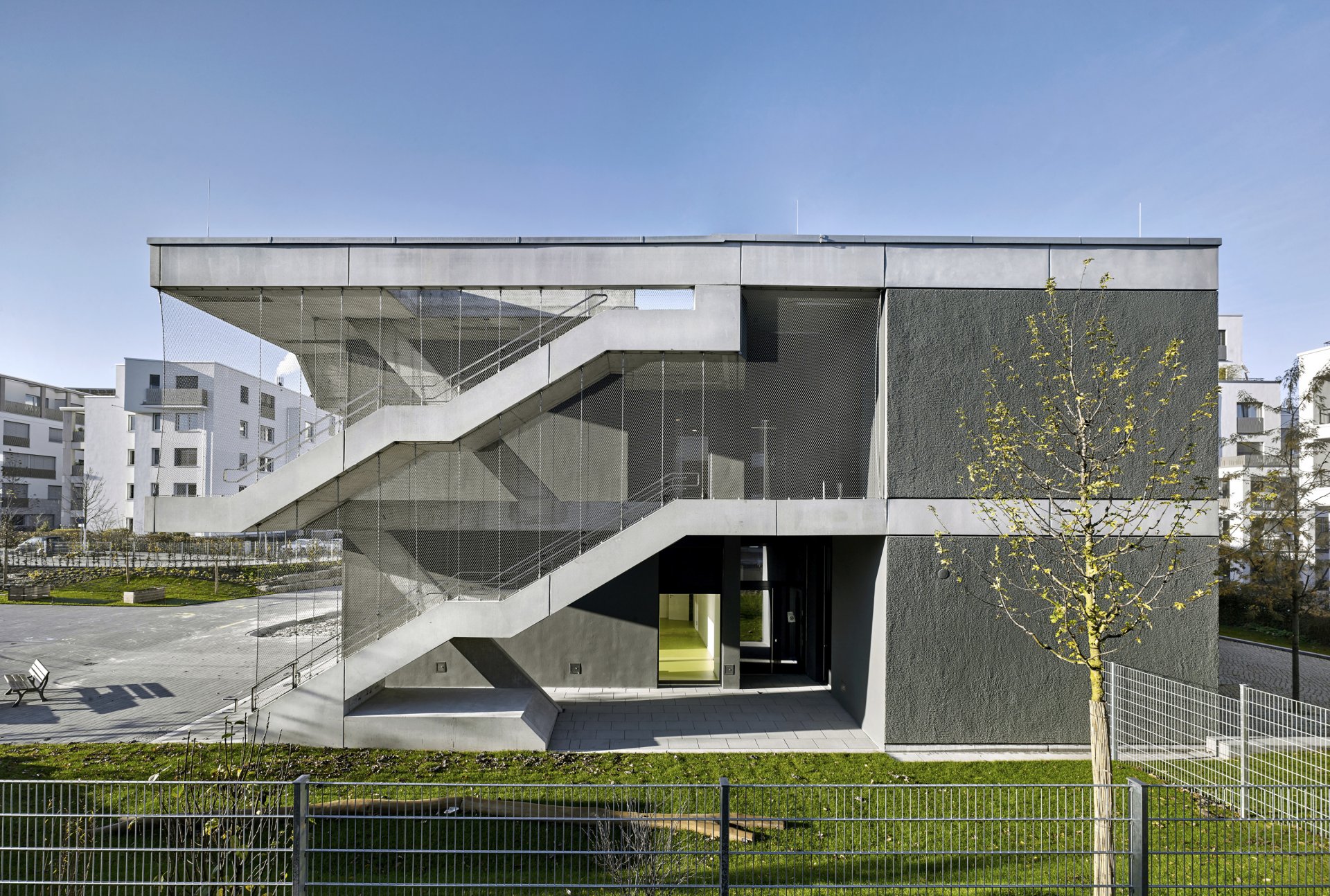
Client
Actris GmbH
Team
Georg Kratzenstein (Projektleitung), Fernando Caballero, Emanuel Gießen, Sabine Hertel, Philipp Schams, Dorothée Wilhelmi
Location
Frankfurt am Main
Completion
2021
Gross Floor Area
2700 m²
CONCEPTS | METHODS | STRATEGIES
The architectural expression of the buildings we have designed varies immensely. Nonetheless, they are based on an explicit architectural stance and share the same design approach.
1. Conceptual
As we see it, an architect should pay close attention to the actual conditions and allow them to develop fully. The logic of what is real imposes limits on the architect’s ideas, and any subjective thrust to the architecture is reduced to a minimum. After all, finding is more important than inventing. At the same time, it is important to transcend the existing situation intellectually and this ultimately transform it into an architectural design. It follows that our fundamental concern is to bear with the ambivalence between the actual parameters and what they inevitably translate into and come up with something beneficial in the process. To do this you must be capable of seeing precisely what already exists, be fascinated by it, but also let it inspire you to go beyond it if necessary.
This is why our concept entails us working with perceptions, images and associations, combining them with the practical parameters of the respective brief.
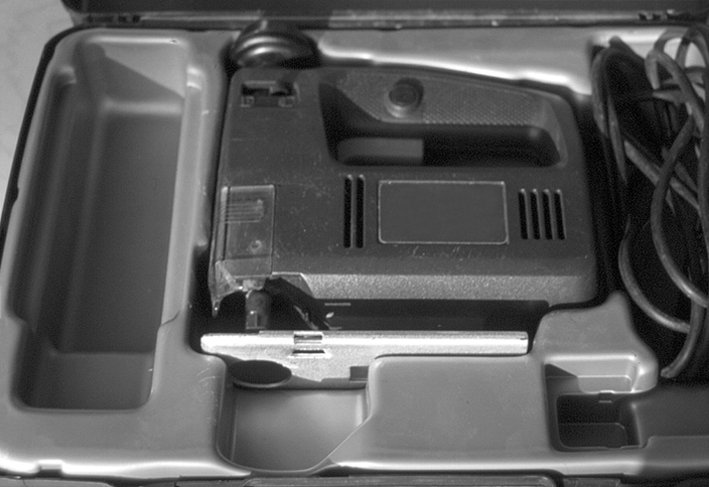
Association object: Jigsaw in case
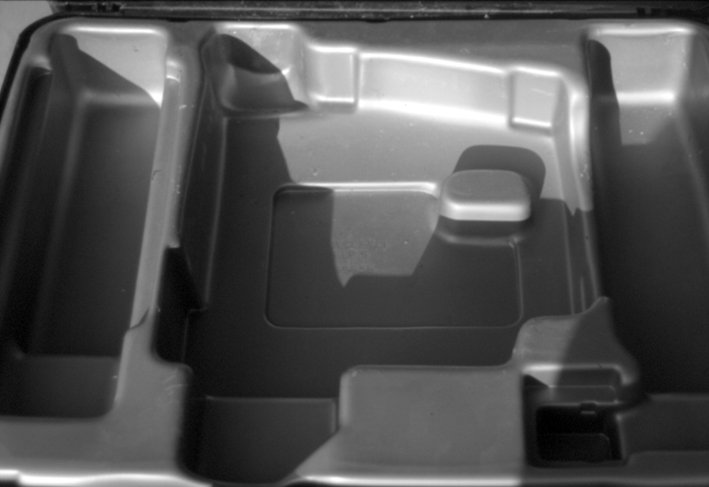
Sheath of the saw case
Design process
We begin each design process by researching and thoroughly analyzing the specific features of a place and the brief. This involves exploring historical, cultural and symbolic layers and teasing out their vibrancy. Based on these insights, we collect all the possible associations that occur to us. Typically, these thoughts are closely bound up with the particular features of the place, existing architecture and brief. They emerge from a precise observation of everyday things, their arrangement and significance. These features might be furnished interiors or the items that generally shape a space, but can equally be existing, urban situations, the historical layers of a building or the history of a place. We then translate these authentic spatial structures and constellations that have developed naturally into model studies with a view to revitalizing the space at our disposal as perceptual space, space for reflection and space for social interaction.
Transformation
In our design process the analysis of the existing circumstances merges with the transformation of existing situations or buildings. Specifically, we rely on intellectual associations and the images derived from them. What at first sight might appear to be a kind of ready-made becomes the basis for a new reality, which neither ignores its position in a given context nor the conditions under which it evolved. This approach also emphatically draws on past building typologies and techniques.
As such, our approach to architecture is based on our essentially seeing everything we do as a transformation or a conversion of existing situations. This is why the buildings we design respond sensitively to their immediate surroundings and urban context. At the same time, they also develop a sculptural impact. We resolve the seeming contradiction this produces by applying specially developed methods that are established practice in the world of contemporary art.
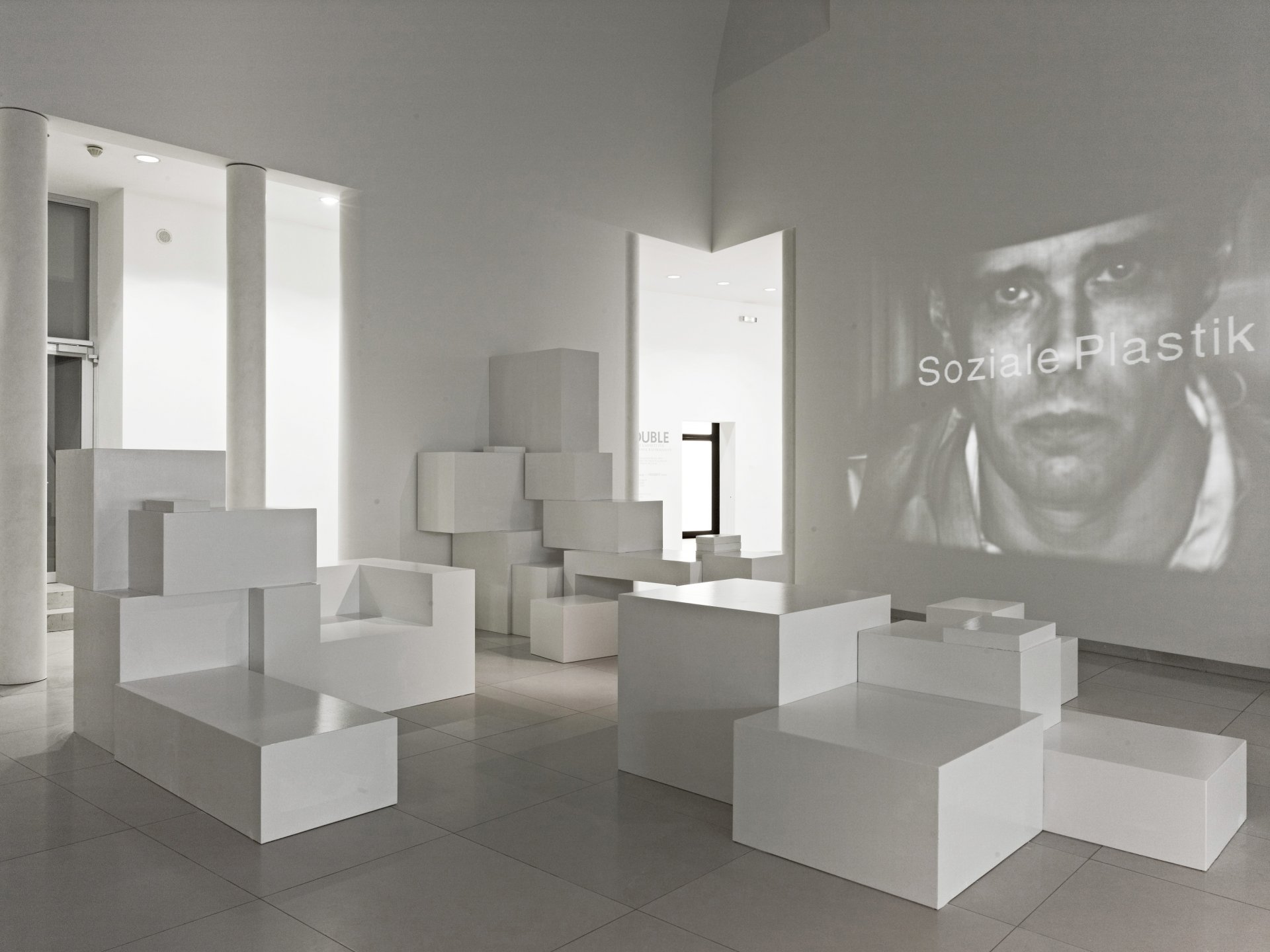
For the project Reading Room at the Museum für Moderne Kunst Frankfurt an abstract version of the study of an “intellectual compulsive hoarder” was created using multiple stacks of books.
2. Operative
Apart from realizing individual projects we also continually develop spatial studies that are not commissioned and in which spaces are played through on varying scales and explored in an exemplary manner.
Drawing on an idea from concept art we employ calculated experimentation with levels of perception and chains of association to kick off the design process; a method that produces solutions which might seem natural but are also surprising.
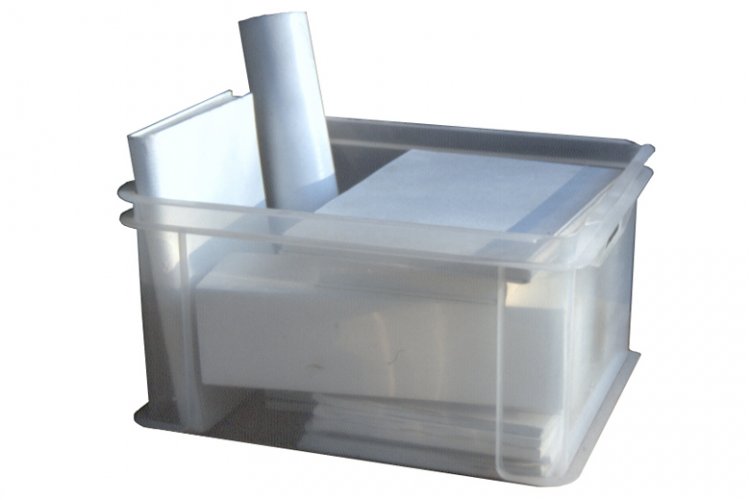
A filled box as starting point for a steel sculpture
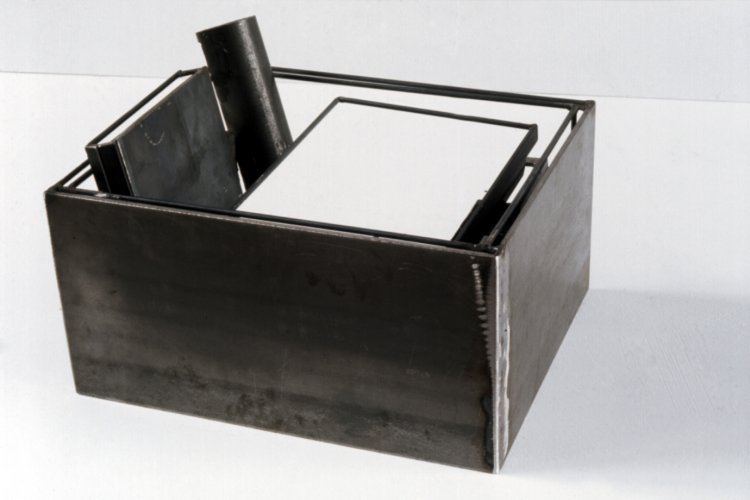
Front view of the steel sculpture. The full box is easily recognizable.
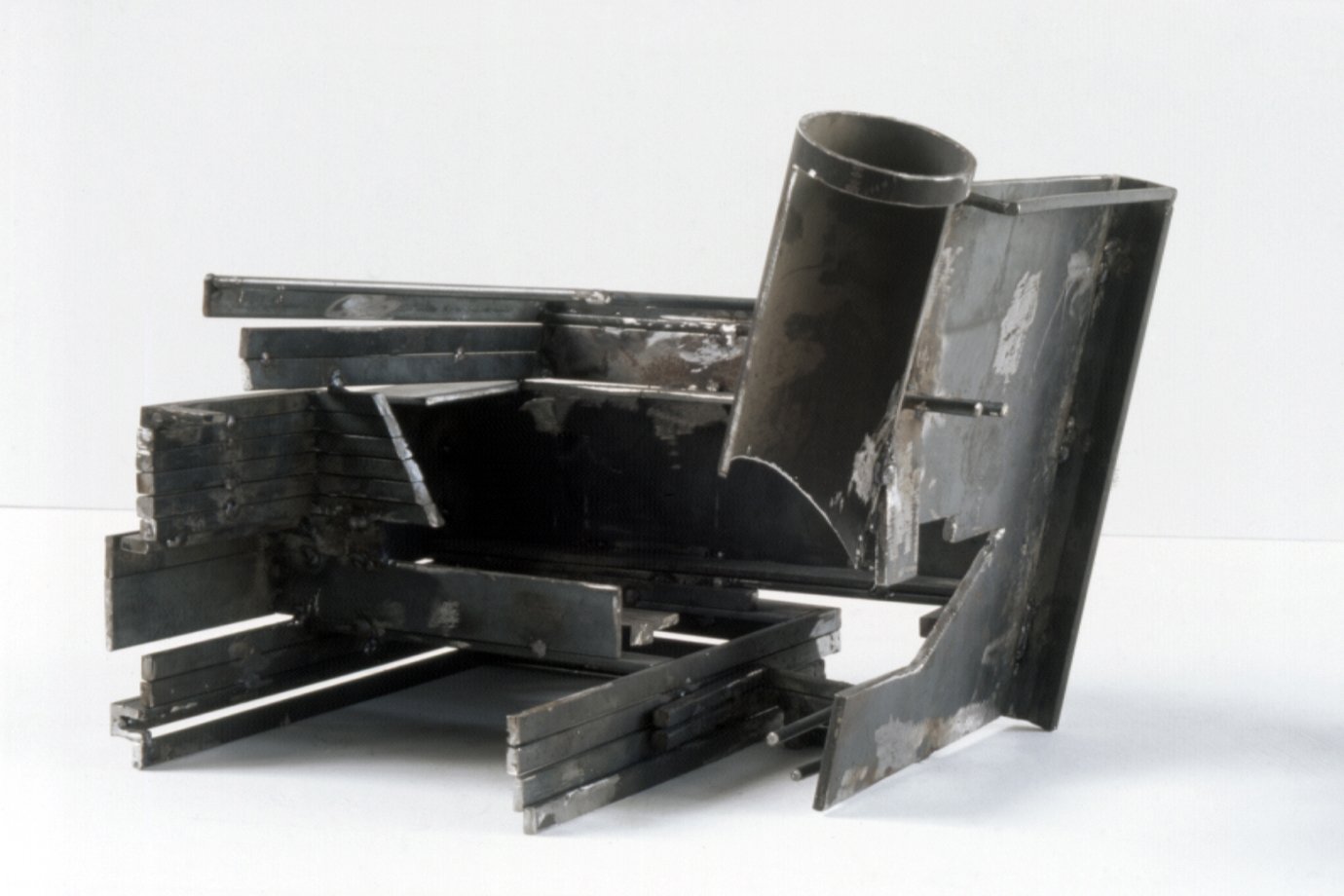
From behind, the steel sculpture reveals a totally different, abstract form.
Things suffused with human experiences, spatial and urban constellations are transformed graphically, sculpturally and architecturally.
Whether designing a new building or converting an existing one we place the focus firmly on perception – particularly regarding the ambivalence of mass and space, concreteness and abstraction. Existing buildings and constellations are infused with diverse social experiences that trigger specific associations. By identifying and analyzing their complex significance vibrant uses and means of social interaction in real space emerge. This creates a new view of places, buildings and things that in turn stimulates new ways of combining various images, atmospheres and uses.
We also engage in our own spatial studies – and have elaborated them over the years. They focus on examining and exploring examples of urban and urban planning concepts, spatial structures, building typology structures as well as artistic issues.
3. Exemplary
Spatial studies and projects
Over the years we have developed the following spatial concepts drawing on the methods described earlier. Through a series of sculptures, model studies and drawings we have examined how spatial concepts can be developed and realized not only considering the relationship between line, surface and space, but also between drawing and sculpture, representationalism and abstraction.
Steel sculptures
The steel sculptures by Florian Schlüter are conceived as walk-through drawings transposed into the realm of the three-dimensional. They revolve around the ambivalence between concepts such as mass and space, concreteness and abstraction and are aimed at exploring the authenticity of the everyday. These inconsistencies become integrated into later architecture projects as fundamental aspects of them.
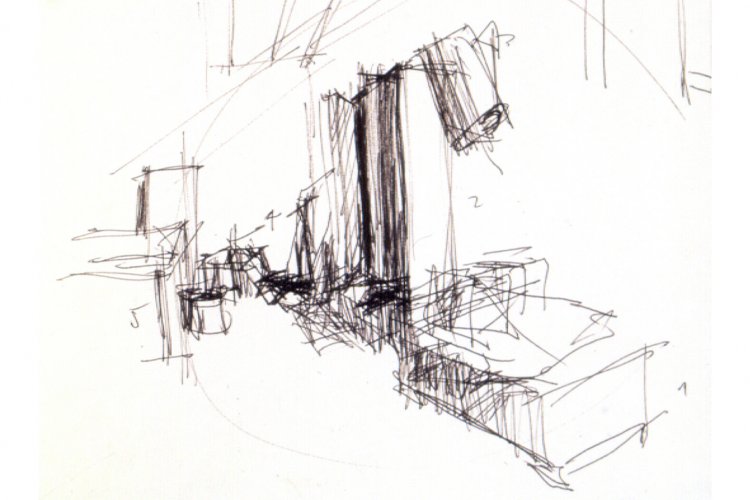
Steel sculpture "Room 01", sketch
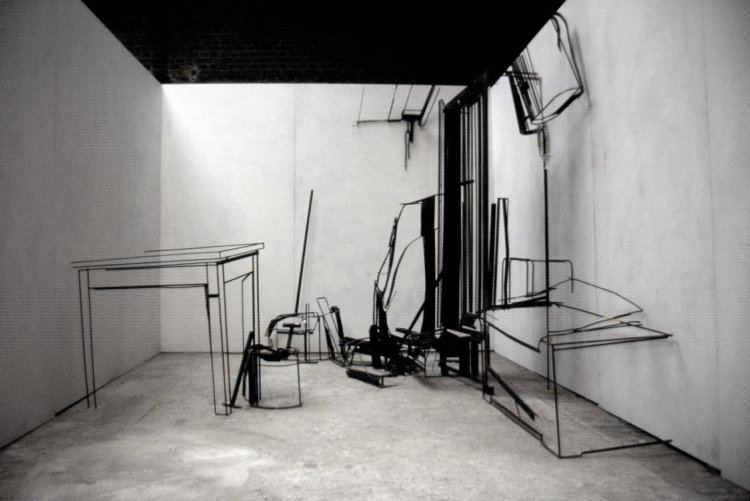
Steel sculpture "Room 01", front view
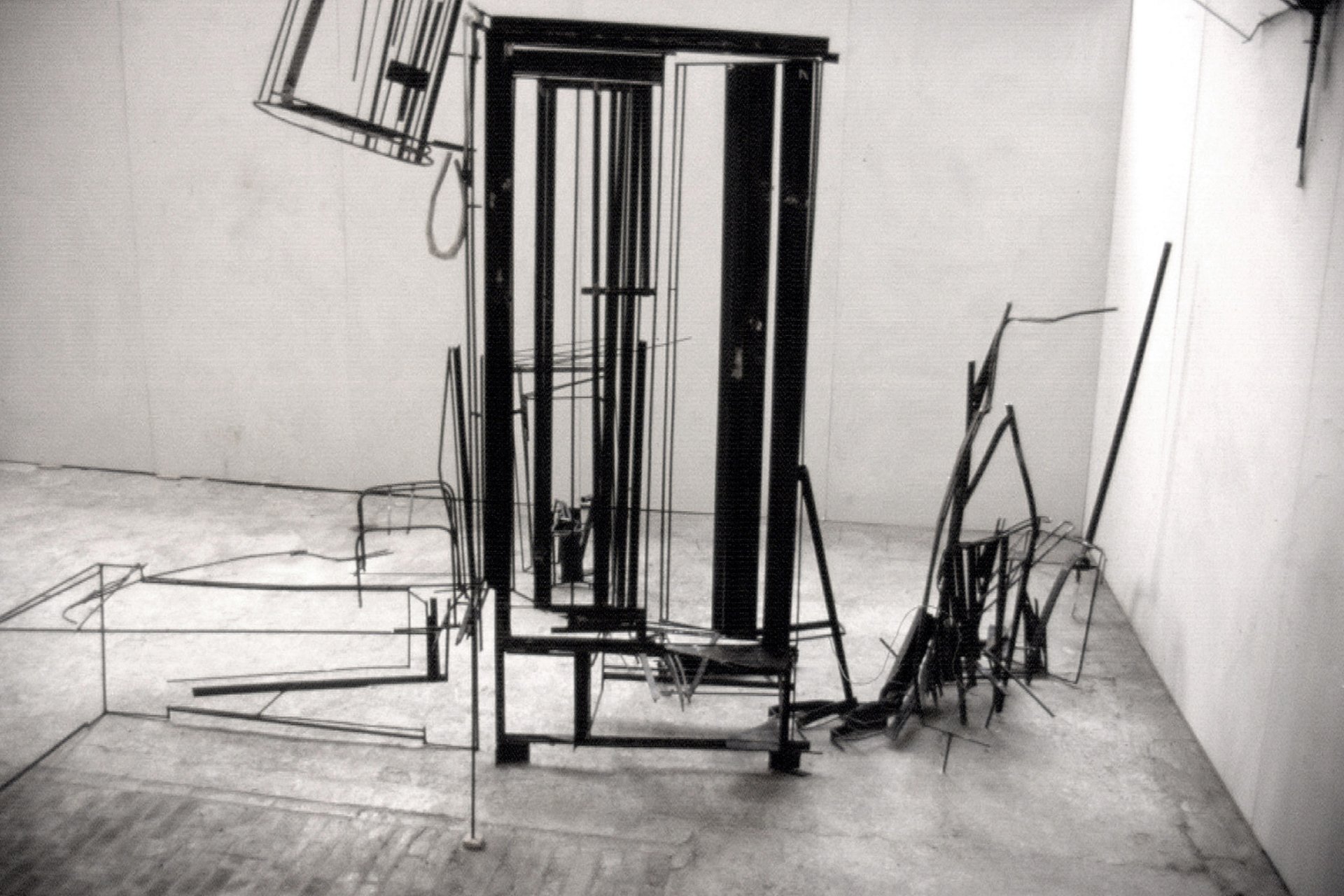
Steel sculpture "Room 01", side view
Studies of urban space
In various studies of urban space, Claudia Meixner employs drawings, paintings and models to penetrate the relationship between mass and space, space as a complement of mass and space, mass and intervening space. Her starting points are both abstract but also specific urban constellations whose given sensual and material design become the point of departure for a transformation that can culminate in a new take on reality.
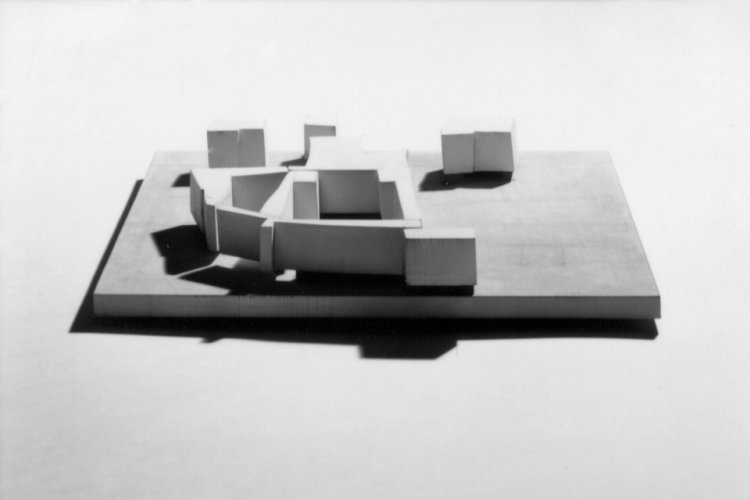
Study of urban space 01
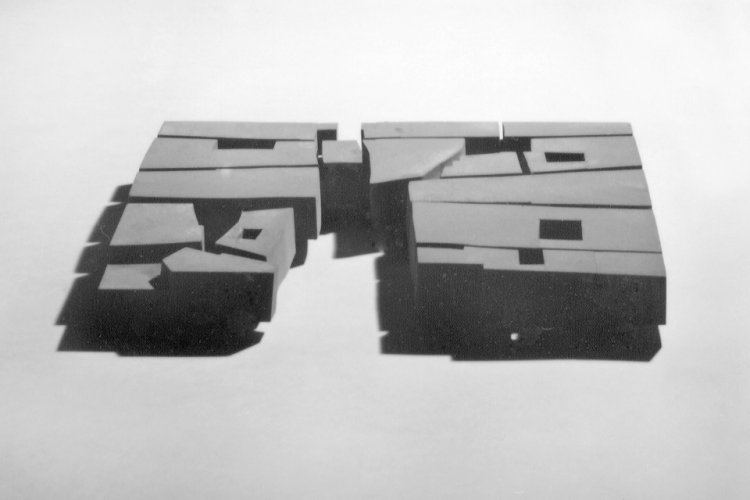
Study of urban space 02
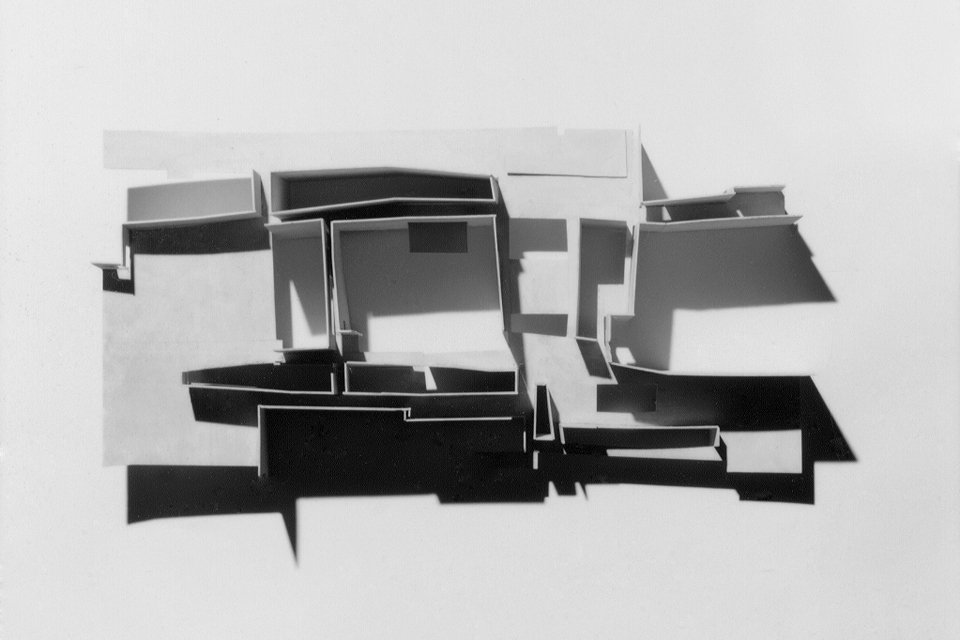
Study of urban space 03
Building prototypes
Moreover, a series of model studies and installations are used to realize potential buildings. Complex spatial concepts are developed through addressing issues on the relationship between shell and core, the importance and function of interstices and elements in space.
Here furniture or furnishing elements in interiors are taken as the starting point. In this model study the constellations that have become usual in everyday life correspond with individual walk-through spaces in a large surrounding space. It is possible to experience the elements and their relationship to the overall space as well as the relationship between the intermediate space and the space as a whole.
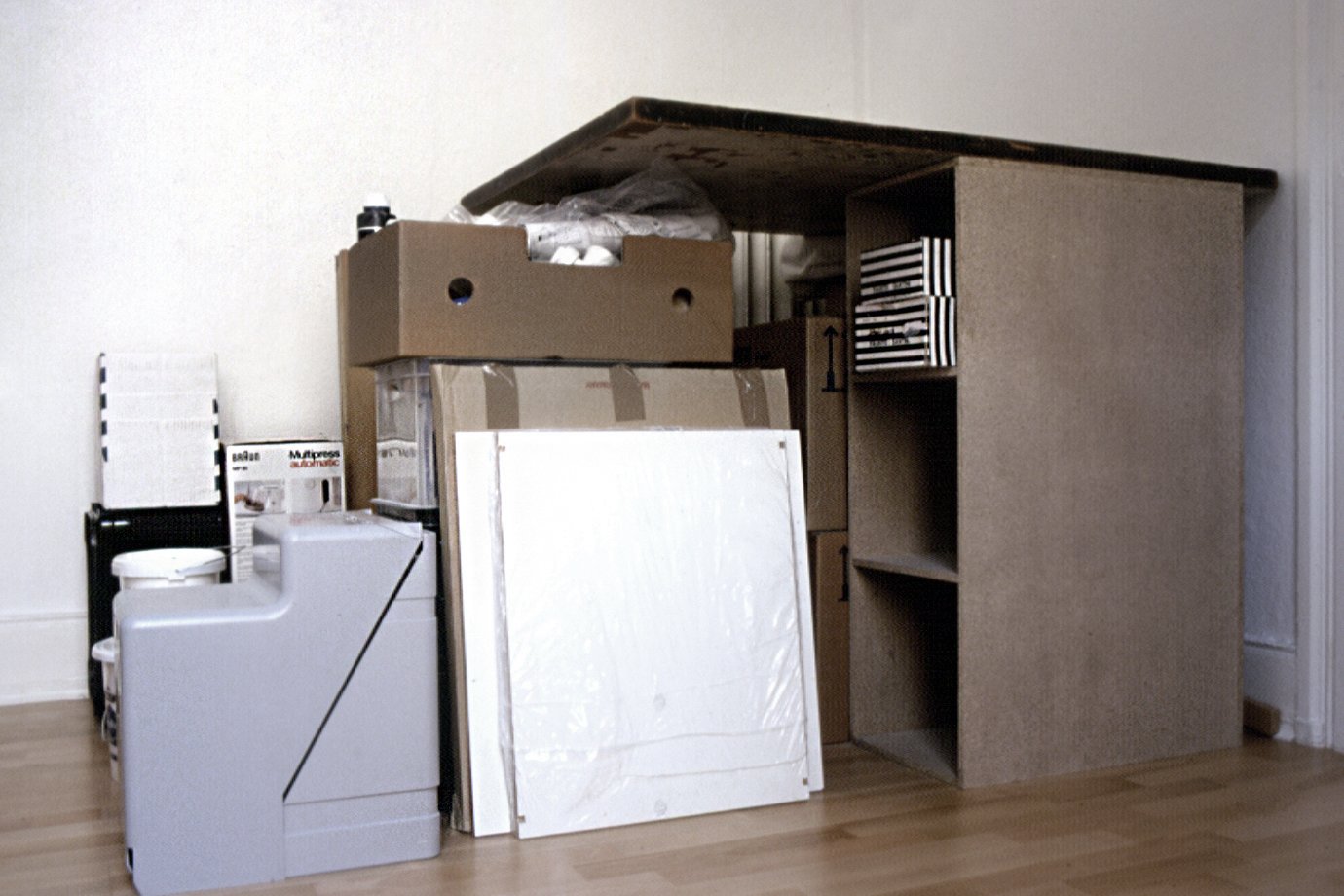
Various objects and arbitrarily stacked boxes as a starting point
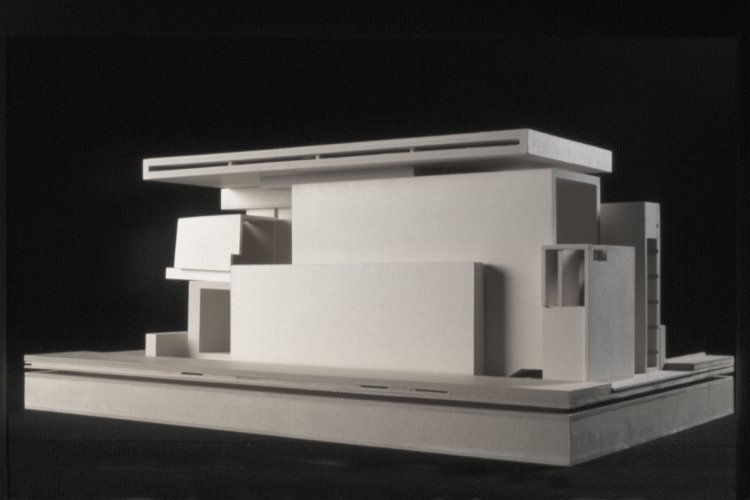
Model of accumulation/stacking
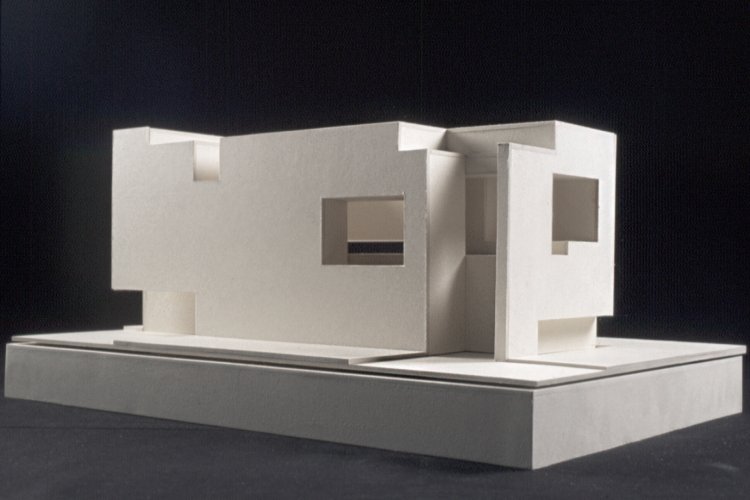
Model intermediate space
In a first model study the starting point was the seemingly chance accumulation and stacking of things. The individual elements in the model represent interior spaces that can be walked through and form intermediate space.
The point of departure for another model study is the shaping and selective filling of intermediate spaces through a stacking and layering of various objects in the space. The relationship between positive and negative is reversed, while that of the volume and mass is redefined. The intermediate space becomes walk-through mass.
Exemplary projects
In addition to the afore-mentioned conceptual parameters, when realizing projects the practical parameters of relevance to the architecture also come into play and influence the substantive concept.
A whole raft of structural means contribute to the success of a sculptural edifice that expresses tranquility and agitation, gravity and lightness, stability and instability, depending on the overall concept.
Expo pavilion
In designing a pavilion for Expo 2000 the starting point was the geometry of a “simple house” with a saddle roof, a single interior space and several “items of furniture”. By enlarging it ten-fold the things morph into archetypal symbols. Perception per se is addressed and a new perception of the architectural space and the objects in it is created. Depending on the viewer’s angle the house, interior space and garden appear either symbolic, concrete or abstract.
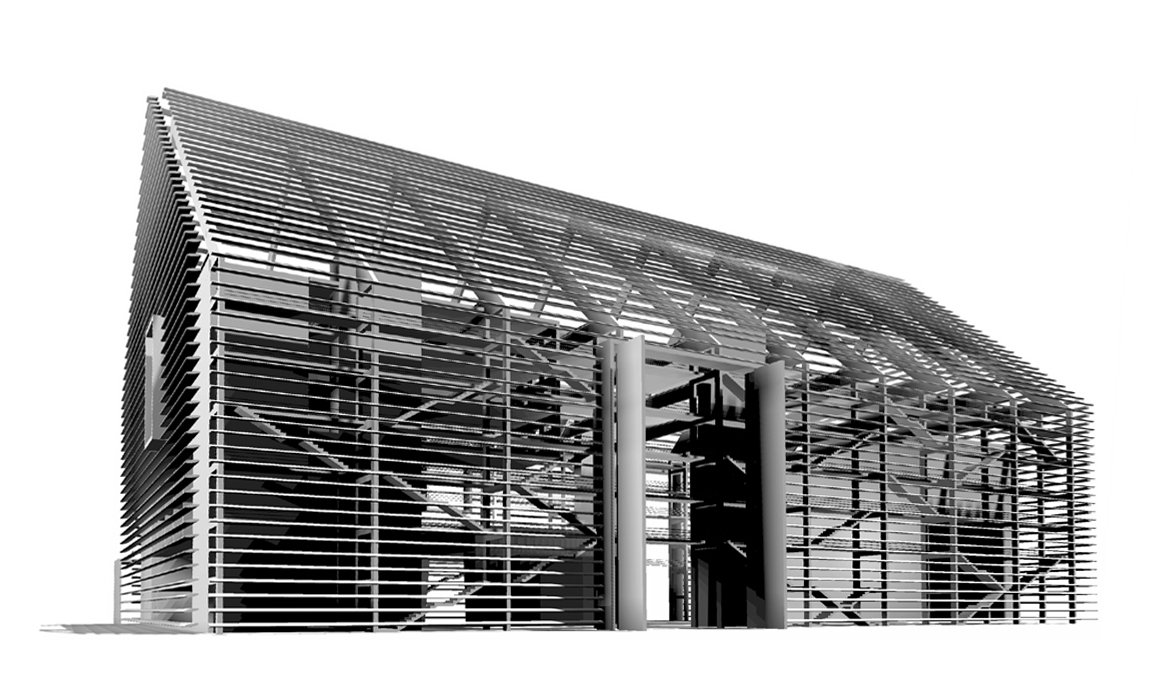
Rendering of the Expo 2000 pavilion
Wohlfahrt-Laymann House
The concept for transforming this residential building developed from the necessity to extend and structurally improve an archetypal house. A new sheath was created that encompasses the entire house. Diverse spatial constellations were produced within the cubic sheath architecture that experiment with the relationship between interior and exterior spaces and the intermediate spaces created as a result.
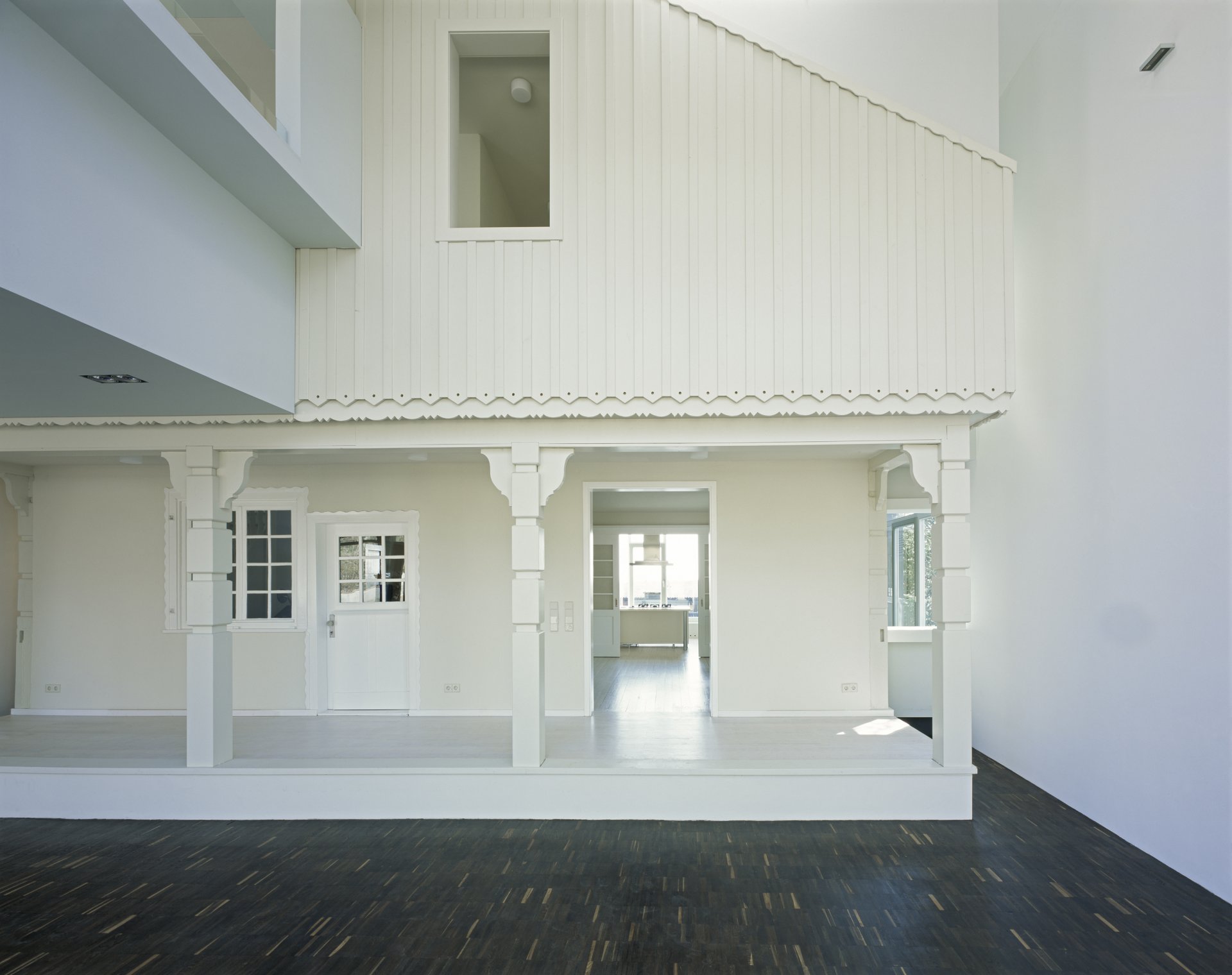
View from the new living room of the old outer facade
Artemide
As part of a project for Artemide, the shapes of several of the manufacturer’s luminaires were regarded as ready-mades, reduced to their essential components, merged with one another and cut out of a compact mass as a negative form. Through the play of light and shadow the resulting polyvalent volume produces a special spatial atmosphere and triggers diverse associations.
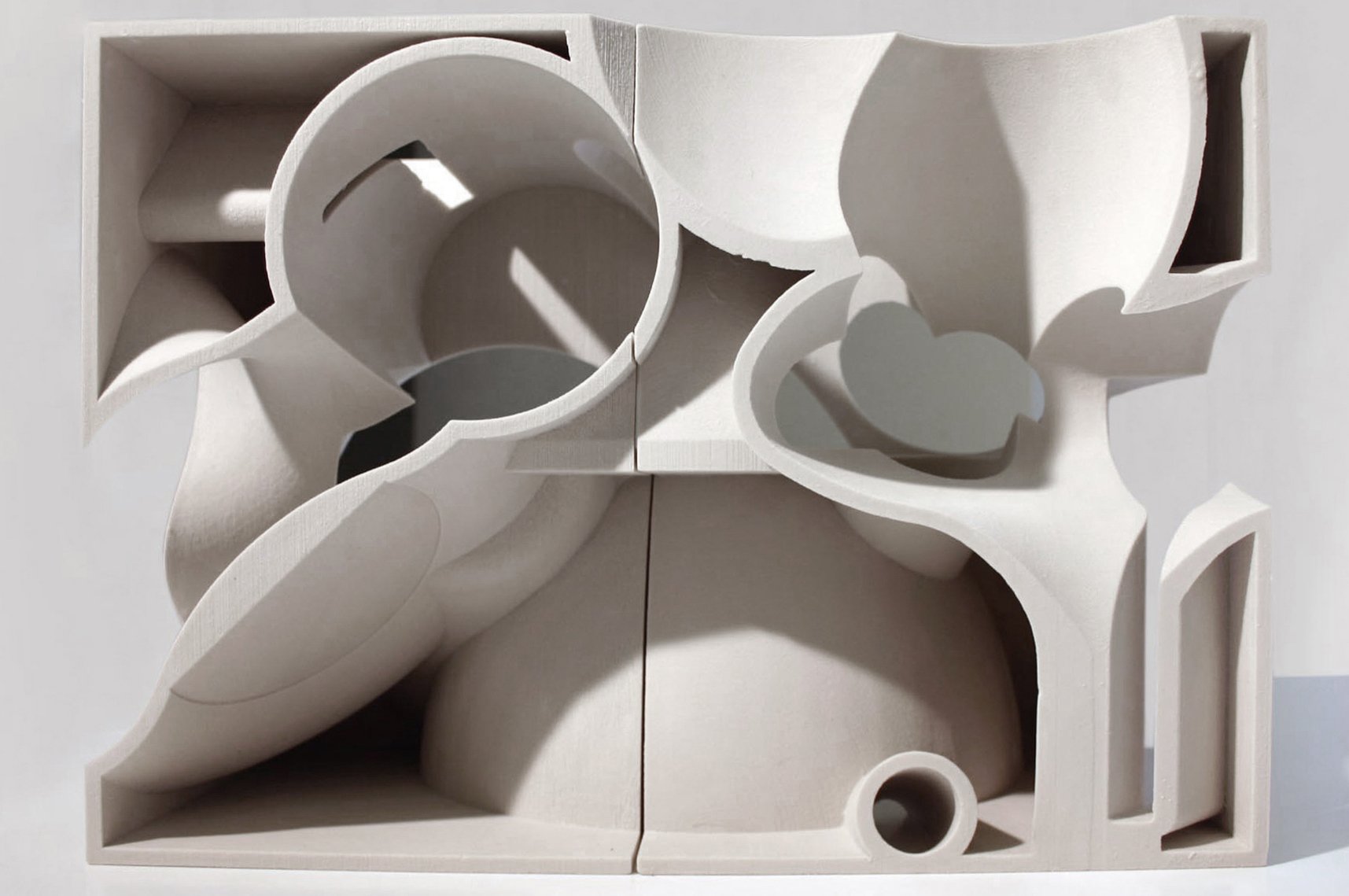
Section of the 3d-printed form
Dornbusch Church
The special nature of the place and the reduction process is made evident in the partial dismantling and conversion of the Dornbusch Church. A new wall marked with indents and molds of the old church and elements that had been removed were used to form a sculpted structure. What is absent remains present in these molds. The perception of area and space is activated and the recollection of its earlier state reinforced.
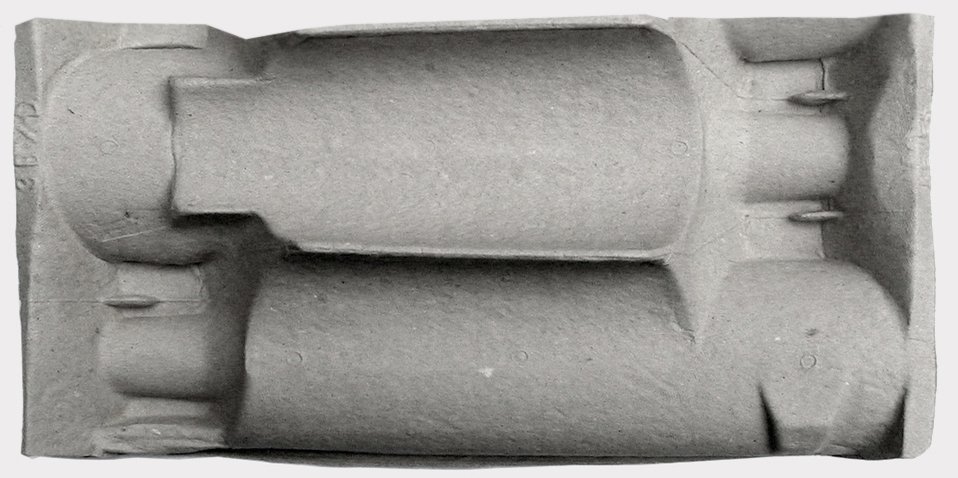
Ausgangspunkt Weinkarton
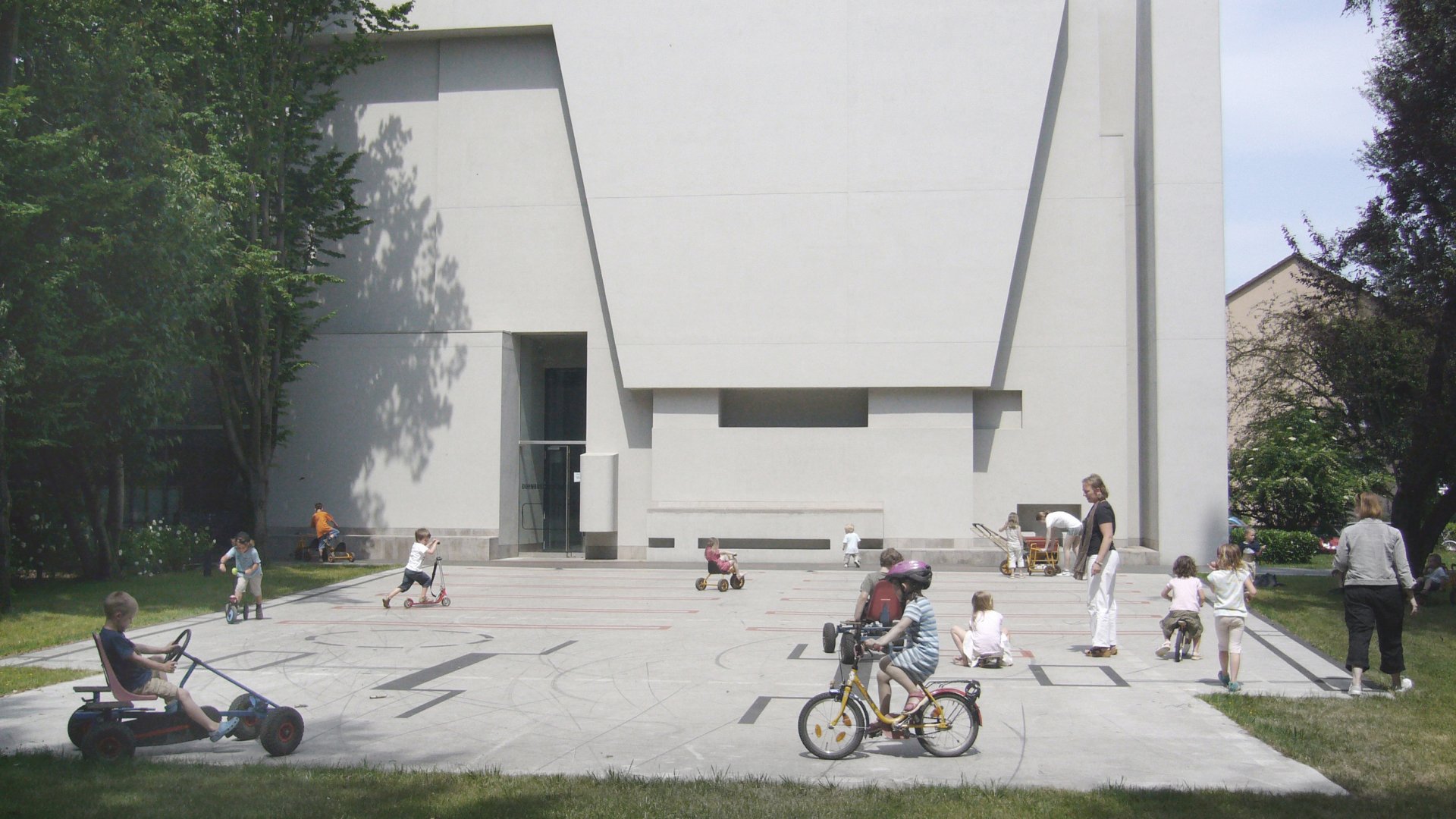
The partly dismantled Dornbusch Church with relief wall and new plaza
In architecture as we understand it everything is basically transformation. We see our task as controlling the ambivalences that emerge during a transformation of an existing structure. This is not only easy on physical resources, but also revitalizes sensual, intellectual and ultimately cultural resources.